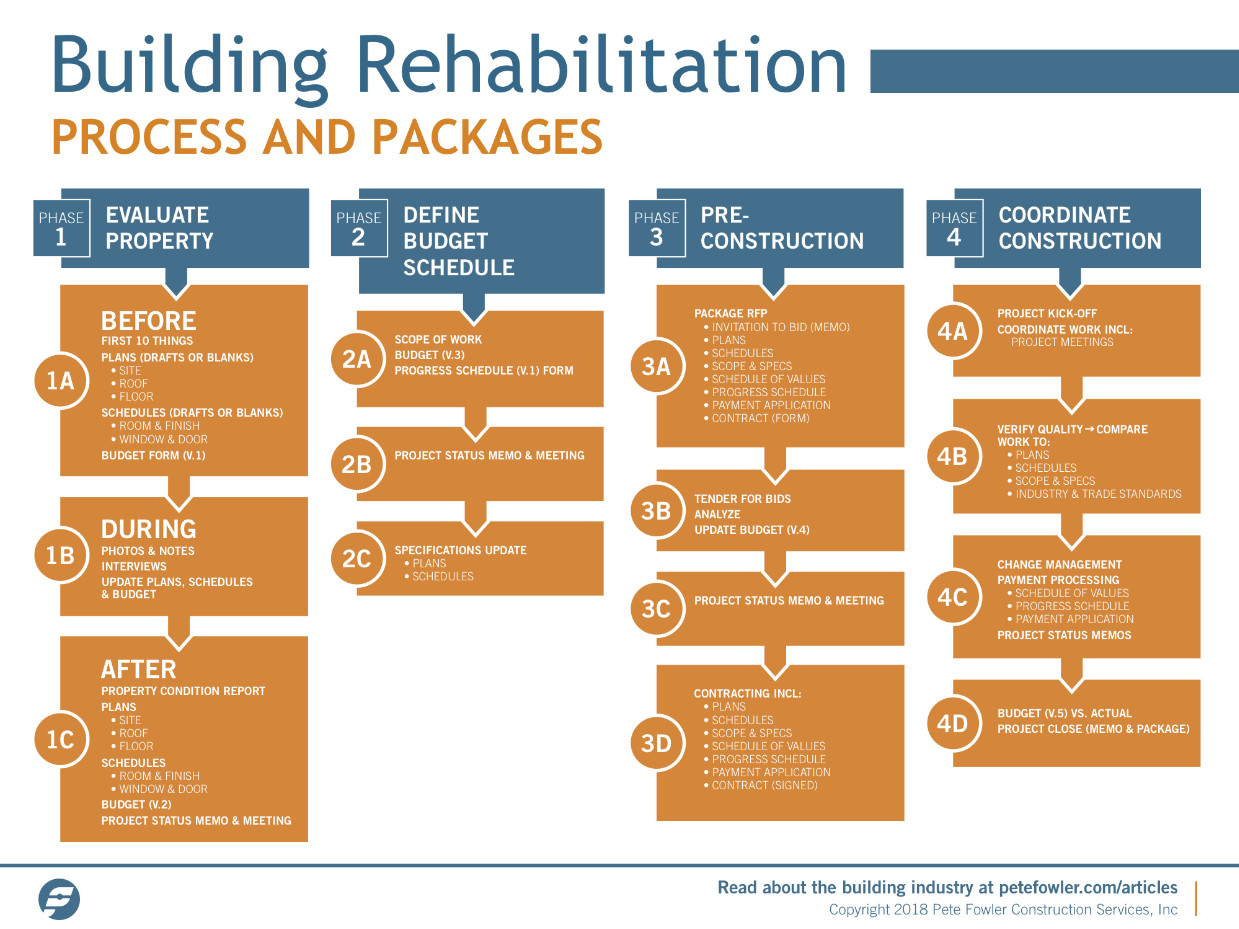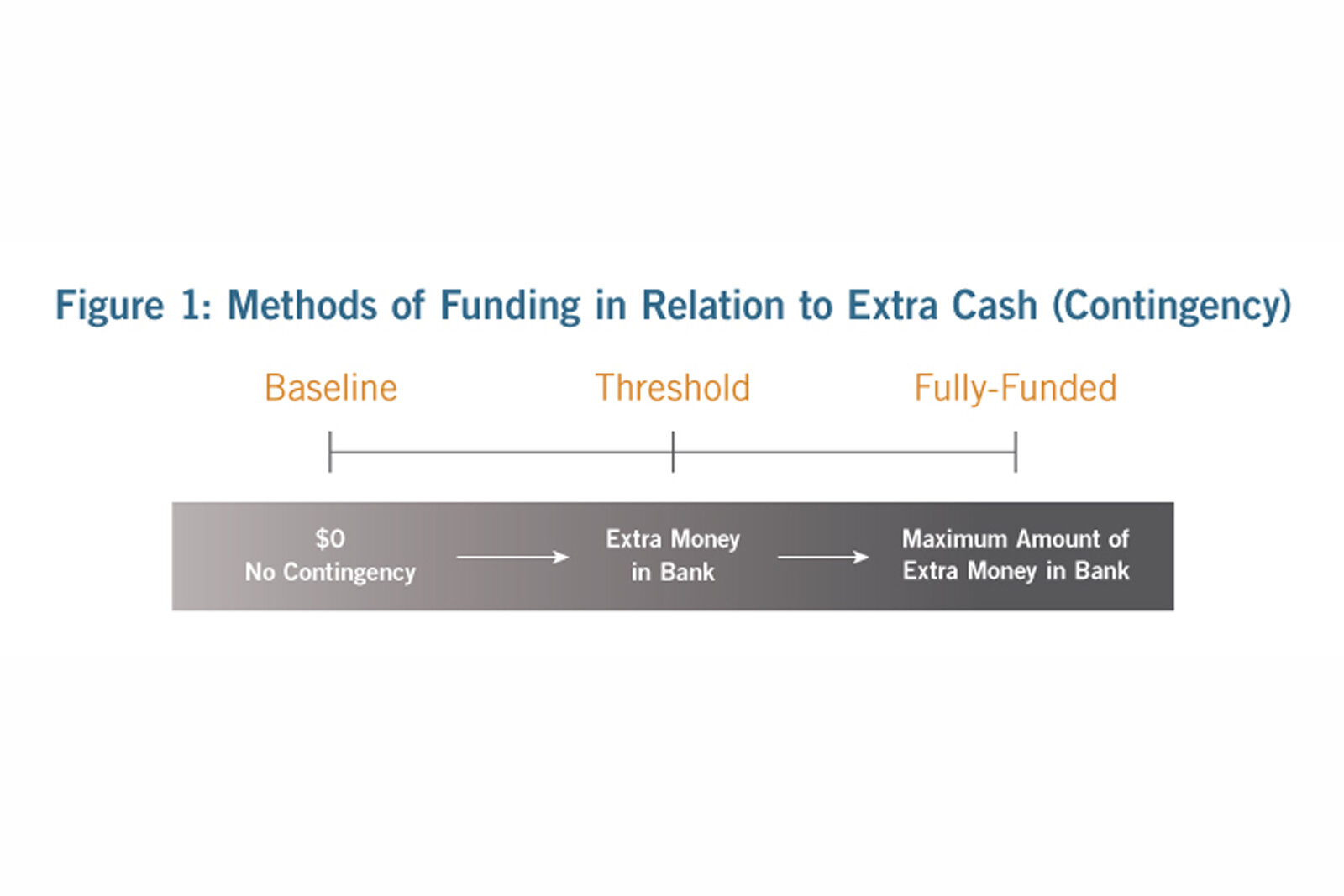I. Define the Scope of Work
The “Define” phase of construction management includes documenting the work to be performed. This can be done graphically and in writing with plans, specifications and detailed “Scope of Work” documents. Getting a clear, specific and detailed project scope is the first step in the construction project management process.
A complete, detailed Scope of Work document moves the parties toward mutual understanding of what is being bought and sold. We have worked on many projects where the owner and the contractor were in dispute, and the root cause was a lack of clarity from the beginning. A maintenance or improvement project with a good “scope of work” is like building on a proper foundation; identifying the scope (quantities) as well as methods to be employed. Until you have specified in writing the location, size, shape, materials, fixtures and workmanship you are envisioning for your project, you are not ready to move forward in the planning process. We suggest creating your own scope of work document, and updating it as necessary throughout the process. Keep in mind that the method used can mean the difference between long term success and failure. As an example, the right paint specification can more than double the life of a paint job.
For many reasons, you should not sign a one or two page “Proposal” from a contractor for a significant property improvement or repair. The Scope of Work will not likely be adequate to clearly define the work specifically enough to protect you if the workmanship is poor. In addition, the contract language will not benefit or protect the owner as well as a contract generated on your behalf. See the next two articles in this series for a more complete discussion of the importance of good construction contracts.
II. Budget
The estimating and budgeting process will be discussed in more detail in the next article in this series. A good estimate for construction is based on lots of assumptions, most importantly, the scope of work. If the scope is a moving target, so will the construction costs. Direct costs of construction are usually categorized by Labor, Materials, Equipment and Subcontractors. Most good contractors estimate what they think construction costs will be, and then add for overhead, profit, other project costs and contingency, to come up with a contract price.
Total construction cost is made up of so many little pieces, that it easily becomes incomprehensible without a system for management. We have worked on many projects in dispute where the records were maintained so poorly that it was impossible to determine the exact costs of construction. Don’t let yourself be the victim of a contractor’s lack of sophistication.
The importance of managing the budget cannot be understated. Before, during and after construction, you should always know where you stand relative to the budget. During the course of construction you should know exactly what you have paid and the approximate remaining amount you will pay to complete the project.
III. Schedule
A schedule can take many forms, but the simplest is a list of activities and when they will be performed. For property maintenance or improvement schedules we like bar charts. A competent contractor should be willing to put a schedule in writing. The owner should add some contingency time of her own, but the schedule can give everyone an idea of what will go on and when. The schedule should serve as a measuring stick to compare plan to actual progress, and everyone can identify problems early.
Scheduling is about communication. A successful project requires communication of expectations with everyone involved, including: owner, designers, contractor(s), government agencies, subcontractors, suppliers, and more. Each activity in construction is usually pretty simple; the greatest difficulty is often in coordination of so many parties. There are often more things to do and coordinate than people can keep organized in their head. Unfortunately, many property maintenance or improvement projects never have a schedule put to paper.
IV. Contract
A contract is a binding agreement. It should be used as a communication tool to make sure all parties understand and agree exactly what is being bought and sold. Like any other powerful tool, it can be dangerous, so be careful. Don’t let the excitement of a big project, a smooth talking contractor, or a busy schedule allow you to gloss over the details.
A prime construction contract is when the contractor has an agreement with the owner. A subcontract is when the prime contractor has someone else do all or a portion of the work covered in the prime contract. Thus, if you contract directly with a “subcontractor” like a painter, this is not a subcontract; it is a prime contract. Prime and subcontractors have different rights and responsibilities. Unfortunately, some prime and sub-contractors do not operate professionally.
All contracts for construction should be in writing. We will be dedicating an entire article to the topic in this series, so we will just hit the high-points here.
At a minimum, a construction contract should contain:
• Full contact information for all parties to the agreement, including contractor license information, physical location of all parties, and a description of the property in question.
• Detailed “Scope of Work” with material, equipment and workmanship specifications. This might include plans, and written specifications describing the work in detail, a list of fixtures, etc.
• Contract Price
• Payment Schedule
• Construction Schedule and any consequences for failure.
Change Orders are a natural part of construction and a contingency for them should be built into the budget. Change orders become a part of the construction contract, should always be in writing, and should be negotiated and signed at the time the change occurs, not at the end of the project.
A payment schedule should be negotiated at the time the contract is signed. Try to never pay more than the value of the work in place. That is, if the project is 50% complete and you have paid 75% of the contract price, then you are in a dangerous position.
Contractors’ lien rights are a complicated collection of legal protections to make sure contractors get paid for improving property. Collection of lien releases verifies that contractors have been paid and protects the property from liens.
V. Coordinate
The “coordinate” phase of construction management takes our planning and puts it to work. We spend a lot of time and energy in the define, budget, schedule, and contract phases, even though we get none of the satisfaction of seeing physical work take place. Remember: When the time to perform has arrived, the time to prepare has passed. If you effectively defined, budgeted, scheduled, and contracted the project, then this phase will go as smoothly as construction ever goes (so there will still be some problems to solve). Coordination of contractors, subcontractors, materials, equipment, inspections, changes, unforeseen conditions, personalities and forces of nature is always a challenge.
In addition to the real “work” of a construction project, the coordinate phase is where the miscommunication, screaming matches, fistfights, litigation and endless frustration often occur; we could also call this phase “Herding Cats”. Stewarding a project from beginning to end requires a combination of construction knowledge, management, sophistication, and patience. While construction is usually a simple assemblage of labor, material, equipment & subcontractors, there are so many moving parts that things regularly can and do go wrong.
Management of construction requires effective communication. Let’s make this as clear as possible: COMMUNICATE, COMMUNICATE, COMMUNICATE (in writing!).
You need to have a filing system for your project and religiously document and file this mountain of information. There are things that should be performed regularly to keep the project progressing. Forms that might be used and/or updated include:
• Scope of Work
• Finish Schedule(s)
• Budget
• Project Schedule
• Change Orders
• Purchase Orders
• Contacts List
• Daily Reports / Log (who did what, how long it took, noteworthy conversations, etc…)
• Safety / Accident Reports
• Inspection Check-Lists
• Municipal inspection (card) information
We don’t have time here to explain all of this in detail, but if you search on the Internet for “construction” followed by the term you do not understand, it will not take long to find an explanation and example form.
VI. Verify
Verifying that the construction is proceeding as planned is critical. This is where we compare our progress to plan. Big problems start small. When we find variations from our plan, we use our documentation system to memorialize. Remember that property improvement contractors have become the #1 consumer complaint in the U.S.; if you do not want to be a sad statistic, then problems need to be nipped-in-the-bud.
The local building department might want to see the project at specified points for life-safety issues. If your contractor tells you that no permit is required, get them to put this fact in writing or call the building department. But the building department is not where inspection ends; we have listened to scores of people bemoaning their fate saying, “where were the city inspectors?” when they had buildings that leaked or were otherwise constructed poorly. The property manager (or inspector for the manager) will want to “verify” at various hold-points to ensure the quantity and quality of workmanship. There may be special assemblies like roofs, decks, windows or weather-resistive assemblies that should be tested to make sure they were constructed appropriately.
The contractor will be asking for payment draws based on the Payment Schedule and you will need to verify the work is complete and built to the standards established in the “define” phase of planning. In addition, the owner will want to collect lien releases for work that is completed and paid.




























